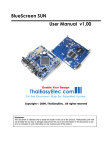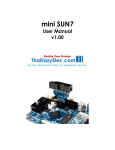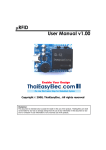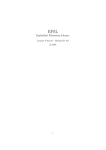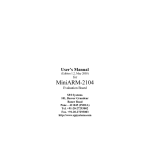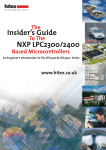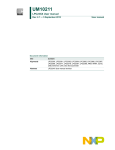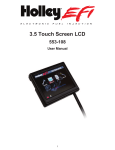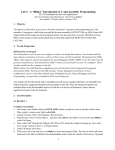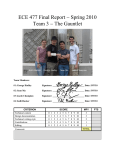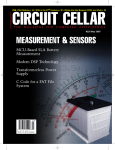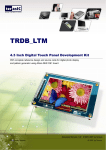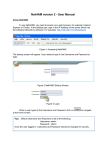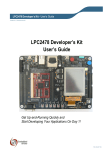Download Blue Screen
Transcript
Blue Screen User Manual v1.00 2 Blue Screen Manual 1. Introduction Blue Screen is a touch screen development board comes with NXP’s powerful ARM7 LPC2378, resistive-type-2.8-inch touch screen TFT LCD, micro-SD card socket and 8kB EEPROM. With full of peripheral drivers and advance software modules e.g. screen object manager, command line interface, SPI interface, I2C interface. The board is suited for all levels of developer. Any technical problem about coding, please feel free to post it in our webboard. 3 Blue Screen Manual 2. Features Hardware - 240x320 pixels TFT LCD with touch screen - NXP’s ARM7 LPC2378 - Micro-SD card socket (connected via SPI interface) support up to 2GB capacity (High capacity: ‘HC’ type not supported) - On board 8kB EEPROM (the last 128 bytes are reserved for screen calibrated parameters) - 1 port ThaiEasyElec’s module connector consisting of SPI and UART signals from MCU - UART connector for command line interface and in-system programming (TTL 3.3v with 5v tolerant) - 16 ports GPIO - Mini-B USB connector (the board is powered from USB connector) Software Demonstrating application - MP3 player with graphic user interface (ThaiEasyElec’s VS1011 Module required) Command line interface software module - Show image from SD card - SD card commands e.g. change directory, list, open read, open write - Audio related commands e.g. play, pause, increase, decrease volume Screen object software module - Design your screen with object oriented method, the running background software will manage which object should be operated Low level drivers - LCD driver Touch screen controller (AD7843) driver Serial port SPI interface I2C interface 4 Blue Screen Manual 3. Requirement - USB cable (type A to mini-B) for supplying the board - ThaiEasyElec’s VS1011 module (optional) for MP3 player application (free earphone) - ThaiEasyElec’s USB to serial and cable (optional) for command line interface - Stylus (optional) - Micro-SD card (optional) - Programmer/Debugger (optional) ULink and mini N-Link are supported VS1011E Module Mini SD Card USB mini B to Serial Stylus mini N-link ARM USB JTAG 5 Blue Screen Manual 4. Drawing 6 Blue Screen Manual 5. Getting start 5.1 Peripherals 1. USB connector (mini-B) 2. Reset button 3. JTAG connector 4. ThaiEasyElec’s module connector 5. Console (command line interface connector, UART0) 6. ISP Jumper 7. Micro-SD card socket 8. 16-bit GPIO 9. 4 green LEDs 10. 2.8-inch touch screen LCD 7 Blue Screen Manual 5.2 Power it on Connect the board with your computer via USB cable as seen in picture. The board shows “Press the screen to recalibrate within 3 (..2..1) seconds”. In this state, if you want to recalibrate the screen, press on it. Anyway, the board is calibrated from our factory so users don’t need to do it again. When the board starts up, it loads calibrated parameters from last 128 bytes of EEPROM (see function AppCalibrateScreen() in app_blue_screen.c). These parameters are used to calculate which point the screen is pressed. They are variable on each board. In case that user overwrites some of these data in EEPROM. At the starting up, the calibration state (picture below) will show automatically without waiting. 8 Blue Screen Manual In order to recalibrate the screen, there would be 25 points on the screen to be pressed. For each point, user needs to touch it twice. For accuracy, please touch it slowly and a stylus should be used. When finishing, the MP3 Player screen will be shown. 5.3 Creating project with Keil The board is supplied with codes. Users have to make project yourself. This guide is an example for Keil. Firstly, you have to create a project. And select the device as “LPC2378” 9 Blue Screen Manual Secondly, set the XTAL frequency as 20 MHz. This is very important; one downloading the firmware via JTAG with wrong setting will cause the board not to be programmable anymore. If this situation occurs, one way to recover is to program it with Flash Magic. Thirdly, replace the LPC2300.s file with the one you got from our website. And then add all other source files (.c) in the project. And also add group “efs” and add all source files in folder “efs”. For more detail about “efs” (stand for embedded file system) see appendix. 10 Blue Screen Manual After these settings, the project should be compiled without any errors (some warnings may occur). The project workspace should be seen as below. 11 Blue Screen Manual 5.4 Source files description Header files (only important files are shown) 1. hw_blue_screen.h : define hardware, for example : TC_CS is at port 2.2 #define TC_CS_DPRT #define TC_CS_PRTS #define TC_CS_PRTC #define TC_CS_PIN FIO2DIR FIO2SET FIO2CLR 2 DPRT : direction port PRTS : port set PRTC : port clear PIN : pin number in the port These may look awkward, but it’s very easy to change some pins. 2. app_config.h : this file is used to configure many parameters various on each project. Header file including are in this file. And this file is included in most of source file. So which declaration shared on more than one source file should be declared on this file. This file also has function declarations from app_blue_screen_demo.c 3. All other header files are subjected to declare functions only. Source files (only important files are shown) 1. main.c : background functions are here including timer interrupt service routine (T0_IRQHandler()), i/o initialization (io_init()). In case that user need to use more peripherals, PINSEL may be set in io_init(). Notice that AppInit() and AppRun() are called from main(), user application may be modified (or recreate) using these functions. 12 Blue Screen Manual 2. app_blue_screen.c : most of application are here except the graphic user interface which is in app_screen_obj.c 3. screen_obj.c : this is the code running in the background of screen object management. From the AppScanPen() in app_blue_screen.c, the screen position and the pen status are send to ScrObjDo(). This point is called “global position” because it refers the hold screen. In ScrObjDo(), each object are determined whether the screen position is in its area considering from its origin and its size. Then “.do()” of targeted object will be processed with “local position” got from minus of global position and the object’s origin. 4. app_screen_obj.c : in this file, each object’s parameter are defined here including origin, horizontal and vertical size, do() and draw() function and etc. A part of code from this file is shown below. #define SO_VOLUME 0 // (1) so_obj[SO_VOLUME].hsize = 16; // (2) so_obj[SO_VOLUME].vsize = 108; // (3) so_obj[SO_VOLUME].horigin = 284; // (4) so_obj[SO_VOLUME].vorigin = 20; // (5) so_obj[SO_VOLUME].stat = SO_ST_ON; // (6) so_obj[SO_VOLUME].val = 60; // (7) so_obj[SO_VOLUME].draw = volume_draw; // (8) so_obj[SO_VOLUME].do_ = volume_do; // (9) so_obj[SO_VOLUME].task100ms = volume_task100ms;// (10) so_obj[SO_VOLUME].is_white = volume_is_white; // (11) Line (1) is to dedicate that, for this screen (MP3 player screen). The volume bar is the number 1 object. Line (2) and (3) define width and height of the object respectively. 13 Blue Screen Manual Line (4) and (5) define horizontal and vertical origin of the object. Line (6) enables this object. Line (7) sets default value of the object (value may be variable for each type of object). Line (8) – (11) set the addresses of these function to there corresponding function. Note that “so_obj” is structure type variable. User may change its parameter when need. So in case that user designs more than one screen in an application. The array “so_obj” can be redefined again and again for each screen. For more detail about “so_obj” please see in screen_obj.h. 5.5 Image generating In the MP3 player application, most of images seen on the screen are generated from JPEG files or Bitmap files with the software called “bmp2h_conv”. The last version is 5.1 allows bigger size of image. This part of manual shows step by step how to implement these pictures into your project. Firstly, create your image using Paint or whatever you like. Secondly, run bmp2h_conv and load your image. The default configurations of this version are supported for this type of LCD. There is nothing to be worried about these options. 14 Blue Screen Manual At “To :” textbox, change the name of image code to anything you like or you may change it later after the header file is generated. This image is named as “pic_button1” in this project. Next, click “Generate” and specify the target file name. Finally, copy the generated file to the project folder and include it. As seen in app_screen_obj.c this image is included as “pic_button1.h”. 15 Blue Screen Manual In order to display this image on the screen, see function bt1_draw() in app_screen_obj.c. First the area is filled with a rectangular. Then it’s overfilled with pic_button1 image with the offset pointer at so_obj[SO_BT1].val*(so_obj[SO_BT1].hsize*so_obj[SO_BT1].vsiz e) with value of “val” at 0-3, four styles button can be displayed occasionally. Notice about “TS_MODE_NORMAL” in function bt1_draw(). This is mode of displaying something on the screen. See appendix for more detail. 16 Blue Screen Manual 5.6 Programming, Debugging and Command line interface 5.6.1 JTAG Interface Blue Screen supports JTAG interface for debugging and programming. Connect JTAG cable so the pin#1 is on the same side with reset switch, see picture below. 17 Blue Screen Manual For Keil’s software, on the target’s option select ‘Debug’ and configure the flash programmer as follow. Also select ‘Settings’ and set MAX JTAG Clock not over than 200kHz if you are using mini N-Link. 18 Blue Screen Manual Back to target’s option select Utilities and configure as follow. 19 Blue Screen Manual Select setting and add programming algorithm as follow. 20 Blue Screen Manual 5.6.2 UART port To communicate the board with command line interface, HyperTerminal can be used. Set the COM port as follow. 21 Blue Screen Manual This UART port also served for ISP (In-system programming), which user can use software like Flash Magic to program the MCU. To do this, place a jumper on J1 and then press reset. Now the MCU should starts with ISP boot loader. 22 Blue Screen Manual Appendix 1. TS_MODE (refers to tslcd_elt240320tp.h) TS_MODE is display mode used in functions start with TSLCD. Now there are 3 modes available, TS_MODE_NORMAL, TS_MODE_INVERSE and TS_MODE_FULL. - TS_MODE_NORMAL : To displaying a circle or some images having white background, user may want this white background to be transparent. Using this mode, all pixel having value 0xFFFF will considered as ‘background’ and it will be display as read-back color. The example of this mode displaying is the volume bar. There you can see blue background instead of white. - TS_MODE_INVERSE : As it’s name “inverse”. The circle or rectangular drawn will have inverse color to the old color. Color parameter sent to the function will be ignored. - TS_MODE_FULL : In case of showing a text message again and again in the same area. You need the use this mode as the blank space will be filled with background color. Anyway, displaying an image (TSLCDShowPic2()) with this mode all color from original image code will be display including white color. Note that a rectangular doesn’t have blank space; in this case TS_MODE_NORMAL and TS_MODE_FULL have same effect. 2. Pen status (refers to app_config.h) Pen status or in code “pstatus” means the current state of pen. This is useful parameter sent to ScrObjDo(). There are 4 available statuses: 23 Blue Screen Manual - PST_NOTFOUND : means that the screen is not pressed. - PST_DOWN : occurs once the screen is pressed. - PST_HOLD : occurs continuously while the screen is pressed. - PST_UP : occurs once the screen is released. 3. Embedded file system library (EFSL) Embedded file system library using in this application is free library downloadable from http://sourceforge.net/projects/efsl/ . It’s limited to SPI only (LPC23xx’s MCI is not supported). It’s very easy to port it to your existing hardware. AVR, NXP’s ARM7, and some other platform have already had example. In this application lpc200_spi.c is modified from original code. It is the bridge between our SPI library and EFSL. Other files is also modified (some lines are commented) to decrease warnings and errors.























